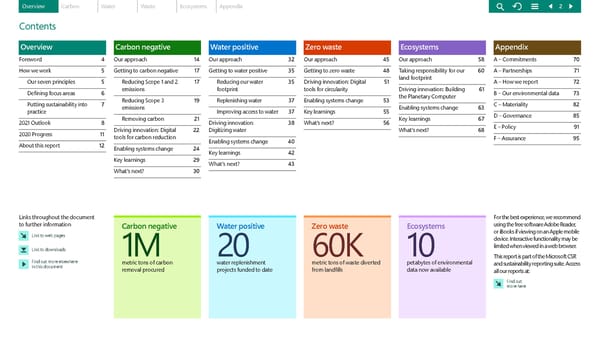Overview Carbon Water Waste Ecosystems Appendix 2 Contents Overview Carbon negative Water positive Zero waste Ecosystems Appendix Foreword 4 Our approach 14 Our approach 32 Our approach 45 Our approach 58 A – Commitments 70 How we work 5 Getting to carbon negative 17 Getting to water positive 35 Getting to zero waste 48 Taking responsibility for our 60 A – Partnerships 71 Our seven principles 5 Reducing Scope 1 and 2 17 Reducing our water 35 Driving innovation: Digital 51 land footprint A – How we report 72 Defining focus areas 6 emissions footprint tools for circularity Driving innovation: Building 61 B – Our environmental data 73 Reducing Scope 3 19 Replenishing water 37 Enabling systems change 53 the Planetary Computer Putting sustainability into 7 emissions Enabling systems change 63 C – Materiality 82 practice Improving access to water 37 Key learnings 55 D – Governance 85 2021 Outlook 8 Removing carbon 21 Driving innovation: 38 What’s next? 56 Key learnings 67 Driving innovation: Digital 22 Digitizing water What’s next? 68 E – Policy 91 2020 Progress 11 tools for carbon reduction F – Assurance 95 About this report 12 Enabling systems change 40 Enabling systems change 24 Key learnings 42 Key learnings 29 What’s next? 43 What’s next? 30 Links throughout the document For the best experience, we recommend to further information Carbon negative Water positive Zero waste Ecosystems using the free software Adobe Reader, Link to web pages or iBooks if viewing on an Apple mobile device. Interactive functionality may be Link to downloads 1M 20 60K 10 limited when viewed in a web browser. This report is part of the Microsoft CSR Find out more elsewhere metric tons of carbon water replenishment metric tons of waste diverted petabytes of environmental and sustainability reporting suite. Access in this document removal procured projects funded to date from landfills data now available all our reports at: Find out more here
 Microsoft Environmental Sustainability Report 2020 Page 1 Page 3
Microsoft Environmental Sustainability Report 2020 Page 1 Page 3